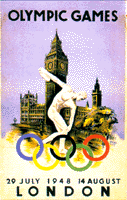HISTORY OF THE MODERN OLYMPICS
London, England, 1948
 |
| Olympic posters from the Archives, Olympic Museum Lausanne, from the book The Olympic Spirit, published by Tehabi Books |
Germany and Japan, the defeated powers, were not invited to participate. The Soviet Union also did not participate, but the Games were the first to be attended by communist nations, including Hungary, Yugoslavia, and Poland. The London Games lacked the new facilities that had been used in Los Angeles and Berlin, but its facilities had survived the war in good condition and were adequate for Olympic competition. Wembley Stadium hosted the opening ceremonies, the track-and-field competition, and other events. There was no Olympic Village; the male athletes were housed at an army camp in Uxbridge, while the women stayed in dormitories at Southlands College.
Over 4,000 athletes from 59 nations participated in the Games. Poor weather and a sloppy track slowed the track-and-field competition, which saw the fewest Olympic records set in the history of the Games. The women's competition was expanded to 10 events with the addition of the 200-metre run, the long jump, and the shot put. Fanny Blankers-Koen, a 30-year old mother of two children, won four gold medals for The Netherlands. Emil Zátopek of Czechoslovakia won the 10,000-metre run, the first of four gold medals in his career. American Robert Mathias became the youngest gold medalist in the decathlon, winning the event at age 17.
Americans, led by diver Sammy Lee, won every men's swimming and diving event. Victoria Draves of the United States earned a gold medal in both platform and springboard diving. The 1948 Olympics featured the debuts of several legendary Olympic performers: László Papp of Hungary won the first of his three boxing gold medals, Paul Elvström of Denmark won the first of his four gold medals in yachting, and Gert Fredriksson of Sweden won the first two of his six kayak gold medals.
Introduction * Early History * Revival of the Olympics * Organization of the Modern Games